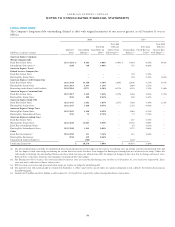American Express 2011 Annual Report Download - page 83
Download and view the complete annual report
Please find page 83 of the 2011 American Express annual report below. You can navigate through the pages in the report by either clicking on the pages listed below, or by using the keyword search tool below to find specific information within the annual report.
AMERICAN EXPRESS COMPANY
NOTES TO CONSOLIDATED FINANCIAL STATEMENTS
investment in ICBC in local currency, and in return the
Company pays to the TRC counterparty an amount equivalent to
any increase in the fair value of its investment in local currency,
along with all dividends paid by ICBC, as well as on-going hedge
costs.
Derivatives may give rise to counterparty credit risk, which is
the risk that a derivative counterparty will default on, or
otherwise be unable to perform pursuant to, an uncollateralized
derivative exposure. The Company manages this risk by
considering the current exposure, which is the replacement cost
of contracts on the measurement date, as well as estimating the
maximum potential value of the contracts over the next 12
months, considering such factors as the volatility of the
underlying or reference index. To mitigate derivative credit risk,
counterparties are required to be pre-approved and rated as
investment grade. Counterparty risk exposures are centrally
monitored and the Company takes risk mitigation actions, when
necessary. Additionally, in order to mitigate the bilateral
counterparty credit risk associated with derivatives, the
Company has in certain instances entered into master netting
agreements with its derivative counterparties, which provide a
right of offset for certain exposures between the parties. To
further mitigate bilateral counterparty credit risk, the Company
exercises its rights under executed credit support agreements
with certain of its derivative counterparties. These agreements
require that, in the event the fair value change in the net
derivatives position between the two parties exceeds certain
dollar thresholds, the party in the net liability position posts
collateral to its counterparty.
In relation to the Company’s credit risk, under the terms of
the derivative agreements it has with its various counterparties,
the Company is not required to either immediately settle any
outstanding liability balances or post collateral upon the
occurrence of a specified credit risk-related event.
The Company’s derivatives are carried at fair value on the
Consolidated Balance Sheets. The accounting for changes in fair
value depends on the instruments’ intended use and the resulting
hedge designation, if any, as discussed below. Refer to Note 3 for
a description of the Company’s methodology for determining the
fair value of its derivatives.
The following table summarizes the total fair value, excluding interest accruals, of derivative assets and liabilities as of December 31:
Other Assets
Fair Value
Other Liabilities
Fair Value
(Millions) 2011 2010 2011 2010
Derivatives designated as hedging instruments:
Interest rate contracts
Fair value hedges $ 999 $ 909 $–$38
Cash flow hedges –2113
Total return contract
Fair value hedge 13 –––
Foreign exchange contracts
Net investment hedges 344 66 44 272
Total derivatives designated as hedging instruments $ 1,356 $ 977 $45$ 323
Derivatives not designated as hedging instruments:
Interest rate contracts $1$3$–$3
Foreign exchange contracts, including certain embedded derivatives(a) 159 109 60 91
Equity-linked embedded derivative(b) ––32
Total derivatives not designated as hedging instruments 160 112 63 96
Total derivatives, gross $ 1,516 $ 1,089 $ 108 $ 419
Cash collateral netting(c) (587) –––
Derivative asset and derivative liability netting(c) (14) (18) (14) (18)
Total derivatives, net $ 915 $ 1,071 $94$ 401
(a) Includes foreign currency derivatives embedded in certain operating agreements.
(b) Represents an equity-linked derivative embedded in one of the Company’s investment securities.
(c) As permitted under GAAP, balances represent the netting of cash collateral received and posted under credit support agreements, and the netting of derivative assets
and derivative liabilities under master netting agreements.
DERIVATIVE FINANCIAL INSTRUMENTS THAT
QUALIFY FOR HEDGE ACCOUNTING
Derivatives executed for hedge accounting purposes are
documented and designated as such when the Company enters
into the contracts. In accordance with its risk management
policies, the Company structures its hedges with very similar
terms to the hedged items. The Company formally assesses, at
inception of the hedge accounting relationship and on a quarterly
basis, whether derivatives designated as hedges are highly effective
in offsetting the fair value or cash flows of the hedged items. These
assessments usually are made through the application of a
regression analysis method. If it is determined that a derivative is
not highly effective as a hedge, the Company will discontinue the
application of hedge accounting.
81
























